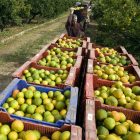Agribusiness
Chlorpyrifos banned by the EU
|
Updated 6th of December 2019 at 17.59
The Member States voted today yes to ban chlorpyrifos from the market. Prohibited
by a vote. Chlorpyrifos and chlorpyrifos-methyl, two pesticides harmful to the
brains of fetuses and young children, are now undesirable in the European Union
(EU). During a meeting of the the Standing Committee on Plants, Animals, Food
and Feed (SCOPAFF) on Friday 6 December, the Member State representatives voted
against the renewal of the authorisation for both insecticides, which was due
to expire on 31 January 2020. According to two sources, the ban on chlorpyrifos-methyl, which was uncertain, got 68.34% of the votes (in such committees, a qualified majority requires 55% of the Member States representing at least 65% of the EU population).
